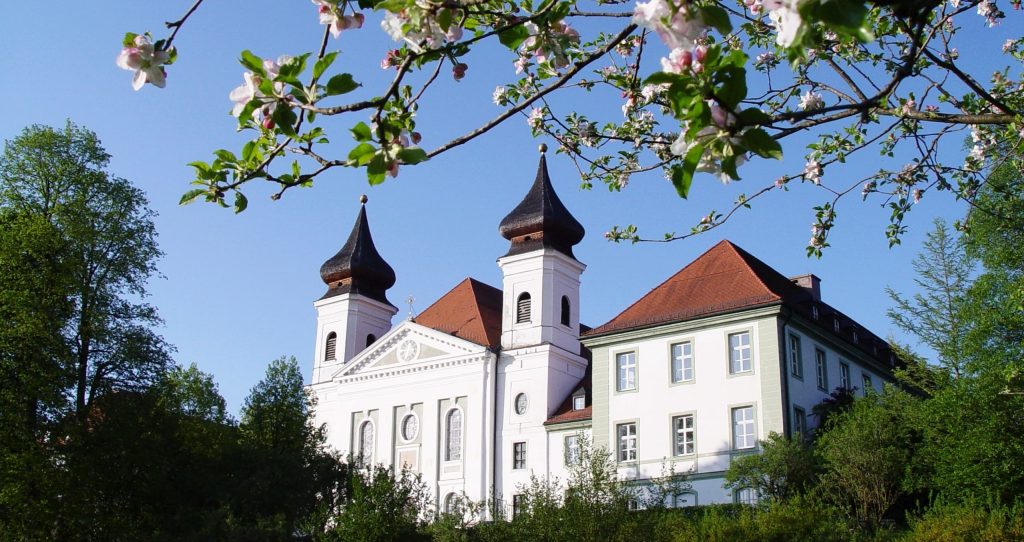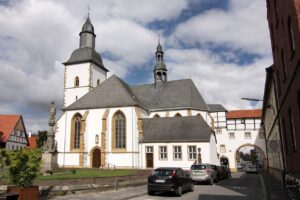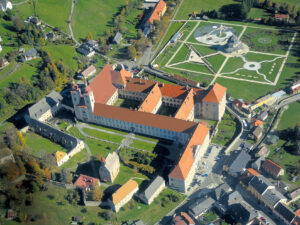
Kloster Blüten in Munich. Source: Photo: Sister Josefa Thusbaß/Schlehdorf Monastery
For many people, the “beacons” of charismatic founders (Columban, Pirmin, Benedict, Martin, Francis, Clara, Dominic, Hildegard v. B. and others) have been burning in Europe for over 1,500 years. The monasteries founded by daring transformers of the world – with the support of noble patronage – served formerly religious virtuosos, nuns and monks, sisters and brothers as “laboratories of holy living” (I), as spiritual centres for communal praying and singing, growing and maturing in humility and orientation towards the Gospel. In the desire for wisdom-filled depth, Benedictine values or Franciscan spirituality, more and more seekers of meaning and those shaken by crises are drawn to such “different places”.
The increasing fascination with monasteries enjoys artistic-cultural building ensembles and scenic resources as “deceleration islands” and “oases of resonance”. However, hospitality, community and home behind permeable monastery walls can now only be provided by a small number of convents. In their “social laboratories” (II), they look after their own existence and the social needs of people in their surroundings – more and more with lay employees.
The current regional and tourist appeal of many monasteries is based on their function and significance as “academies of knowledge” (III). Since the 8th century, they have created the cultural, pedagogical and scientific prerequisites for our European educational, cultural, technical and economic civilisation in Central Europe as monastery and cathedral schools, with libraries and university cooperatives.
Without the community of goods practised by solidarity comrades in the “monasteries as economic enterprises” (IV), they would not have been able to operate communally and commercially (e.g. mining and smelting of ores, salt production, glassworks and breweries). Thus, monasteries still prove to be economic-utopian spaces for the creation of ethical-religious-cooperative behaviour and wise economic management (cf. Isabelle Jonveaux), with the types of production economy (monastery-owned products), activity economy (outsourcing), asset economy (ownership of land, real estate, share deals), donation and old-age economy (pensions of older members).
Epochal upheaval and “monastery death” – Quo vadis monastery?
Economic turbulence, quality and professionalisation demands have also affected the monasteries in the last 30 years. In the absence of their shrinking staff, many of the religious orders and larger monasteries have initiated major restructuring. They expanded their previous status as an association or corporation with a limited liability company or foundation for their entrepreneurial activities in hospitals or nursing homes. As social “business enterprises” they continue to offer “work” to hundreds of thousands of employees in the brewery to the educational house, in the host bakery to the hospice and in forest and meadow use to the wellness hotel.
In the face of growing tendencies towards erosion within the orders and convents, paralysing resignation and destructive lethargy are also becoming noticeable in them. Despite a surge of professionalisation in the management of monasteries (with experts in economics from outside the order) – the Europe-wide “dying of the monastery” can no longer be ignored.
In the past 90 years, the number of women religious in Germany has fallen from around 70,000 to 20,000, while the number of men religious has halved to 4,700.
A crisis of new blood and ageing, abuse scandals in churches and religious orders and increased resignations are the outward signs of a spiritual and mental change that, like the invisible “Corona pandemic”, has taken hold of the last places of “religious origin of reality” (Kitaro Nishida).
Since many monasteries have stood empty, resourceful mayors and district councillors, creative people, estate agents and private investors have discovered the “monastery property” as a cultural asset worthy of protection. As potential buyers, they – and no longer just responsible dioceses or Vatican institutes – are taking over historically significant, listed former “cells” in need of renovation (e.g. the monasteries in Ahrweiler, Bernried, Mindelheim, Schlehdorf, etc.), and with them the urban valuable land that has become scarce.
For years, monasteries and religious orders have been faced with the challenge and increasingly urgent decisions of considering the future of their diminishing convents:
- How are monasteries and religious orders themselves coping with this epochal upheaval?
- Do they leave their “disused lighthouses”, large empty building complexes in need of renovation, to society (through a monastery sale) or do they find innovative forms of design for their business areas

St. Marien Monastery in Wiedenbrück, Germany. Author: Joachim K. Löckener
A new old trend in community building
The number of cooperatives in Germany has increased to almost 8,000 in recent years. Their legal and business structure lends itself as a modern, innovative and sustainable economic model for future-oriented problem solving. There are cooperatives for citizens, education, energy, health, consumption, agriculture, neighbourhoods, schools, pupils, senior citizens – as cultural, social and housing cooperatives.
In contrast to this trend of modern community building, which is also evident in the founding of a large number of ecological-spiritual community villages, the energy of monastic convents is dwindling and – the “cooperative” (in the succession of Robert Owen, F.W. Raiffeisen et al.) is suddenly emerging as a monastery successor and new owner:
- The housing cooperative in Munich, for example, took over most of the Schlehdorf monastery and the newly founded “Klostergut Schlehdorf” cooperative had already taken over agriculture, seminary buildings, etc. before.
- After the dissolution of the Franciscan monastery in Rheda-Wiedenbrück, a monastery cooperative eG was formed from former visitors to continue the seminary operations and the monastery grounds.
- In these weeks, a “Kloster-Genossenschaft Oase” (Monastery Cooperative Oasis) has been founded, which will buy the Neusatzeck Monastery in the Black Forest, abandoned by the Missionary Dominican Sisters, and revitalise it with a living community.
- The Benedictine “Klostergut Wessobrunn” was handed over in hereditary lease to the municipality, and now to the “Maro-Genossenschaft” for renovation and construction of flats
The combination of religion and culture, of community building and civic engagement in the “monastery transitions” mentioned above opens up new spaces for monasteries and civil society. The question is:
- Is the takeover of monasteries by business investors or by cooperatives replacing the “monastic power” of the soul of Europe – and does this reveal a “second secularisation” (Markus Ries)?
- Does the interest in “cooperatives” (as a social seed for the future) confront monasteries with the decision to humbly offer an “empty space” for their succession – or does it exhort monasteries and religious orders to open up a free space in the monastery in which a transformation of spiritual-community life can and must take place through cooperation with cooperatives (new community and economic forms)?
Leap innovations in the 19th century
The founding of a “monastic cooperative” could provide many monasteries with a breath of fresh air for the upcoming tasks of monastic change and departure into the future. For monasteries have been energetic “cooperatives” ever since their beginnings as eremitic brotherly communities of goods (“Let all things be common”, Acts 4:32).
And it is not without reason that since the so-called “religious spring” in the 19th century, the communities founded at that time to alleviate social need and then incorporated into a religious order have called themselves “religious cooperatives” to this day (e.g. the Missionary Benedictines of St. Ottilien). Their flourishing at that time took place on the basis of free, self-organised living and earlier (dead) brotherhoods, beguines and begardens, which were then incorporated into religious orders for their legal business in church and community.
The vision of a “societas caritatis” & “vita communis” as well as a fraternal “cooperativity” inspired the founding of monasteries in the 19th century, as did F.W. Raiffeisen, who himself wanted to found a monastery-like community with his employees in the 1860s.
Monastic principles and cooperative values henceforth mutually formed the basis of religious and secular cooperatives:
- Monasteries continued to practice hospitality, community of goods, collegiality and a social responsibility ethic.
- The Raiffeisen-oriented cooperatives invoke self-help, solidarity, freedom and order.
In their “two-handed double nature”, monasteries and cooperatives with their values and principles could contribute to a renewal of communal life and work. The prerequisite for this would be to remember:
- that monasteries in the (early) Middle Ages often grew out of free associations, brotherhoods, of which, for example, the Franciscans in the 15th century already developed their own cooperative “banking activities” for the redistribution of money and goods in the care of the poor and sick. Examples: The “Monti di pieta” in Italy with small loans and low interest rates or the “Göttingen Georgs-Kalande”.
- that social politicians (such as Franz Hitze, Heinrich Pesch and Charles Gide) or bishops (such as Emmanuel von Ketteler) in the 19th century vehemently demanded social assistance, subsidiarity and solidarism, cooperation and the common good with the help of cooperatives. Encyclicals of some popes and documents of bishops’ conferences appealed for the right to form cooperatives, ownership, participation and solidarity.

St Lambrecht Monastery in Murau, Austria. Source: Benedictine Monastery of St. Lambrecht
Monastery cooperatives as part of a new “WE”.
The creative combination of both related community forms, monastery and cooperative, would be an ideal complement for many monasteries.
Instead of leasing out individual areas (such as agriculture), joint cooperative projects with suppliers, customers, cooperation partners and monastery sympathisers could be created in the ongoing operation of their “externalised activity economy”.
The following already successfully practise this cooperative form of economy as part of the monastery’s overall activities
- St. Lambrecht Abbey
- the monastery of Ettal with surrounding farmers and milk suppliers in a “Bio-Masse-Heizwerk-Genossenschaft” and a “Käserei-Genossenschaft” respectively. Since 1961
- Neustift Monastery, Brixen, has been working extremely successfully with the surrounding winegrowers in a “wine production cooperative”.
- the Selbitz Monastery and the St. Ottilien Monastery in their participation in biogas plants with regional cooperative sheep.
The business areas of a “monastery cooperative” to be formed could also include education, monastery shops, agriculture, forestry and forestry, but also mission projects, pilgrimages and publishing work; new forms of neighbourhood living and new forms of living together in solidarity with war and climate refugees would also be suitable for a monastery cooperative.
In its bodies (supervisory board and board of directors), members of the convent and other participants, committed monastery friends and time comrades, customers, suppliers and cooperation partners from the “ecosystem” of the monastery would sit together as equals in a new community of solidarity, as members, owners and customers.
- This could revive a cultural impulse of the 19th century: Back then, many Catholic priests were the “drivers” of cooperative foundations; today, the monasteries (as community foundations built in stone) could become the “drivers” of new cooperative initiatives.
Transformability – Key Competence for the Monastic Future
Our planetary responsibility for climate change and the necessary changes in ways of living and working require new places of learning and experimentation where spiritual-social-ecological conversion can be practised holistically and transdisciplinary. This would correspond exactly to the call of the “Stockholm Resilience Centre” of 2012 for a necessary “future skill“: a future competence of “transformability”.
“Future skill” appears to be necessary in monasteries and religious orders for their resilience, transitions and transformations, so that
- in an existing convent or
- after the end of the convent and a necessary sale of the convent
- something new emerges, another form of life and community building,
- which, through the succession structure in a previous “holy place”, shows itself to be open to the future and must be recognised,
- because the previous spiritual, monastic, ecclesiastical and economic structures as framework conditions of monastic life are no longer sustainable, dissolve themselves and thus require “something new”.
In order for monasteries today and tomorrow to once again function as “innovation laboratories” (Gerd Melville), they must transform themselves, i.e.
- wake up from a “shock rigidity” (monastery-ending), in a kind of “shock therapy” of the Holy Spirit in the souls,
- becoming receptive to people’s longing for a communal and spiritual life (in a sacred place),
- take up their fiduciary responsibility to clarify their “succession” in the monastery and to prepare a project for the future,
- take up the forgotten core of religious orders: the cooperative community in fraternal life and work as a future-proof economic form in the “Common House”, in Europe and on our planet.
In a greeting to the Italian cooperatives, Fr Francis encourages them with the call: “The cooperatives take on everything, they also defy mathematics, because in the cooperative one plus one makes three!
Cooperatives must continue to be the driving force that supports and develops the weaker part of our local communities and civil society.” Civil society is “waiting” for the opening of the doors, gates and windows in the monasteries and the unfolding of a monastic cooperative driving force!
Monastery, we could shout, “Get up, run, open!” (Bernard v. Clairvaux)
- Monasteries left alone become powerless and go down the drain – monasteries with a “cooperative” bubble up again !
- What is no longer possible for a small convent today, can be achieved by cooperative members in cooperation with the convent in a joint legal and economic form of “monastery cooperative”, which is historically linked to the spirit of the “religious cooperatives” that still exist today.
DOWNLOAD APPENDIX OF MONASTIC CO-OPERATIVES
By Berthold Winkler, freelance Catholic theologian, supervisor. “Monastery activist” and “transformation mentor” with his institute KlosterGenovation.





Follow us: